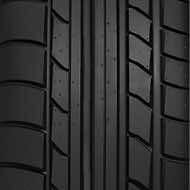Tyre creation and selection is a science and an art in today’s car universe. Unlike the simple rubber ones, today’s tyres are intricately woven mixture of steel belts, highly developed fabrics and rubber compounds. First introduced as cross-ply tyres, now radial tyres are the new industry standard and display many advantages when it comes to wear, heat resistance and rigidity. The picture below shows the detailed thought and engineering applied into the the design of tyres.

Types of Tyre Treads
Standard practice when fitting car tyres is to usually select a tyre with a symmetrical pattern. But as you will know in this article there are many other factors and types of tyres from which you can choose and use for the optimum experience, safety and performance.
Asymmetric Tyres
Many high performance cars are fitted with tyres having special tread patterns. Asymmetric tyres usually have different tread patterns on the inner and outer edges of the tyre which leads to a significant improvement in the performance. There are many commonly found on sports cars.

On the outside edge, the large stiff tread block aids in the cornering of the car. While the smaller tread blocks installed on the inside edge are designed to remove water from the tyre pattern and improve grip on a damp/wet road whereas the middle of the tread is equipped with a continuous rib that can help improve straight line stability. This means the tyre is built to provide optimum all-round performance in both damp and dry conditions, and thus would be a good choice to have for your car.
To ensure that the tires are positioned correctly on the car , the sidewalls of the tyres are usually marked “outside only” and “inside only”. This helps improve the car handling and performance.
Examples of asymmetric tyres include Pirelli P Zero and Continental Sport Contact 2.
Directional Tyres (Uni-Directional)

Directional tyres will usually exhibit an arrowhead-like tread pattern which provides a good looking appearance. But other than the appearance, it also has great qualities and performance attributes.
Directional tyres are specifically designed to rotate in a single direction, so they provide great wet weather performance and directional stability. Due to excellent traction, they are also good performers on the snow covered roads, and that’s the reason many cars designed for snowy conditions have directional tread patterns.
They also are better at dispersing water building up in front of the tyres and reduce road noise as well. So if you live in a snowy area or like to have a bit more grip on the road, these are the tyres for you!
Examples of directional tyres include Goodyear Eagle F1 GSD3 and Michelin Alpin 4.
Multi-directional Tyres
Multi-directional tyres have a similar tread block on both the inner and outer side of the tyre. This allows the tyre to be able to rotate in either direction. It can also be fitted at any position on the vehicle without compromising on performance. These tyres are usually less expensive courtesy their simpler tread design; but also come with an innate disadvantage that they are less able to adapt to changing road conditions unlike the asymmetric tyres. So they are not all-rounders like their counterparts, and while offering excellent grip on dry roads they are not every effective on the damp ones. If you are short on cash and can compromise on performance, this might be a good option.
Examples of multi-directional tyres: Dunlop SP Sport 5000 and Arrowspeed CP661.
Directional/Asymmetrical

Directional/asymmetrical tire tread are a combination of all the good features of other tyres. It has the V-shaped patterns on the directional tread, and this helps in discharging water away from the tire. It also has good dry weather traction due to the asymmetrical tread. Vehicles equipped with tyres of different sizes on the front and rear cut down the car’s ability to be able to rotate using directional/asymmetrical tyres unless they are remounted.
Here is a video explaining the differences and concepts of asymmetric and , multi-directional and directional tyres:
What kind of tyres do you use on your car? Did this article help you pick out the best one for you? Let us know in the comments section!



I really like your blog! Just wanted to write something. Tyre treads are play a very important role.